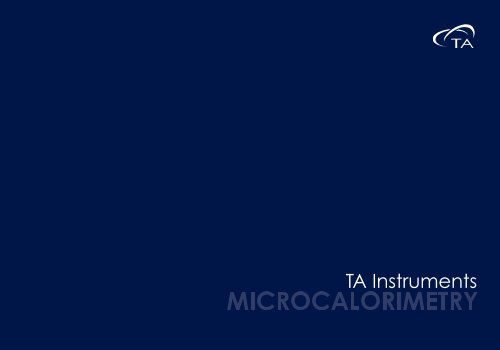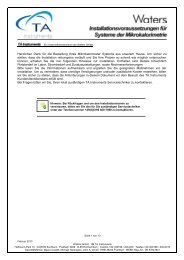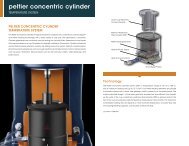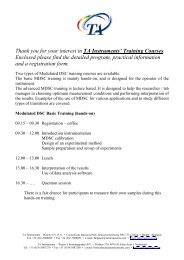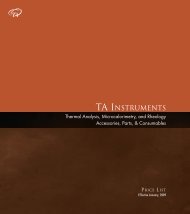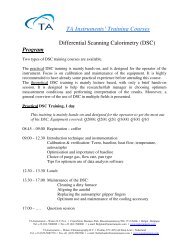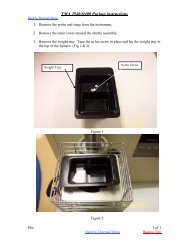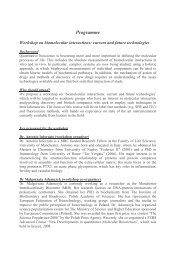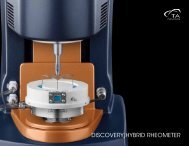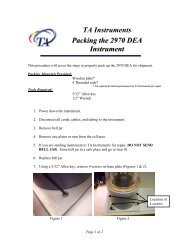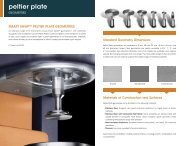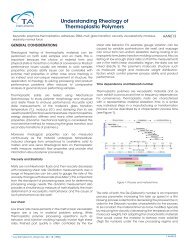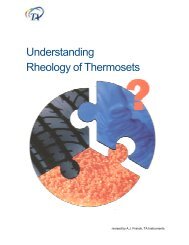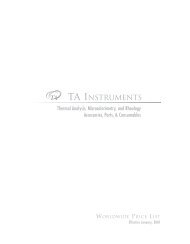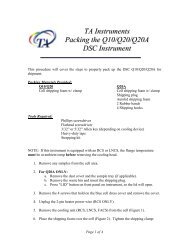Nano DSC Brochure - TA Instruments
Nano DSC Brochure - TA Instruments
Nano DSC Brochure - TA Instruments
You also want an ePaper? Increase the reach of your titles
YUMPU automatically turns print PDFs into web optimized ePapers that Google loves.
<strong>TA</strong> <strong>Instruments</strong>
New Castle, DE USA<br />
Lindon, UT USA<br />
Elstree, United Kingdom<br />
Shanghai, China<br />
Beijing, China<br />
Taipei, Taiwan<br />
Tokyo, Japan<br />
Seoul, South Korea<br />
Bangalore, India<br />
Paris, France<br />
Eschborn, Germany<br />
Brussels, Belgium<br />
Etten-Leur, Netherlands<br />
Sollentuna, Sweden<br />
Milano, Italy<br />
Barcelona, Spain<br />
Melbourne, Australia<br />
Mexico City, Mexico
DIfferenTIal SCannIng Calorimetry<br />
The <strong>Nano</strong> <strong>DSC</strong> is specifically designed to determine<br />
the thermal stability and heat capacity of proteins<br />
and other macro-molecules in dilute solution, with<br />
the versatility and precision to perform molecular<br />
stability screening, ligand binding and pressure<br />
perturbation measurements.<br />
The <strong>TA</strong> <strong>Instruments</strong> <strong>Nano</strong> Series calorimeters represent<br />
the highest sensitivity and unmatched performance for<br />
the investigation of biological samples.
<strong>DSC</strong> SPeCiFiCatioNS<br />
<strong>Nano</strong> <strong>DSC</strong> Specifications<br />
Short-term Noise<br />
0.015 µWatts<br />
Baseline Stability<br />
±0.028 µWatts<br />
Response Time<br />
7 seconds<br />
Operating Temperature -10 °C to 130 °C or 160 °C<br />
Temperature Scan Rate<br />
0.05 °C to 2°C/minute<br />
Pressurization Perturbation<br />
Built-in up to 6 atmospheres<br />
Cell Volume<br />
0.30 ml<br />
Cell Geometry<br />
Fixed capillary<br />
Cell Composition<br />
Platinum<br />
Heat Measurement Type<br />
Power Compensation<br />
Automation Specifications<br />
Sample capacity<br />
Sample tray temperature control range<br />
Available Wash / Rinse Buffer Ports<br />
2 standard plates x 96 wells x 1000 μL / well<br />
4 °C to Ambient<br />
4 for Sample/Reference Cells; 2 for Sample Handling Syringe<br />
14<br />
15
nano <strong>DSC</strong> teChNology<br />
Pressure Ring<br />
The <strong>Nano</strong> <strong>DSC</strong> differential scanning calorimeter is designed to measure the amount of heat absorbed or released by dilute in-solution bio-molecules as they are<br />
heated or cooled. Macromolecules such as proteins respond to heating or cooling by unfolding at a characteristic temperature. The more intrinsically stable the<br />
biopolymer, the higher the midpoint temperature of the unfolding transition. As these processes often exchange microjoule levels of heat, the sensitivity of the<br />
<strong>Nano</strong> <strong>DSC</strong> is critical for successful investigation of the reaction.<br />
The <strong>Nano</strong> <strong>DSC</strong> obtains data with less sample than competitive designs and produces unmatched short term noise (±15 nanowatts) and baseline reproducibility<br />
(±28 nanowatts). Solid-state thermoelectric elements are used to precisely control temperature and a built-in precision linear actuator maintains constant or controlled<br />
variable pressure in the cell. Increased sample throughput is realized by adding on the <strong>Nano</strong> <strong>DSC</strong> Autosampler. It provides true walk-away capability for up to<br />
96 samples. With convenient USB connectivity, built-in pressure perturbation capability and capillary cell design, the <strong>Nano</strong> <strong>DSC</strong> provides maximum flexibility with<br />
a cell design that minimizes sample aggregation and precipitation, resulting in high quality data.<br />
<strong>Nano</strong> <strong>DSC</strong> Capillary Cell<br />
The capillary design of the <strong>Nano</strong> <strong>DSC</strong> provides<br />
unparalleled sensitivity, accuracy and precision.<br />
Many structurally unstable samples that show<br />
aggregation and precipitation during a scan on<br />
competitive designs can be routinely analyzed<br />
on the <strong>Nano</strong> <strong>DSC</strong>.<br />
The <strong>Nano</strong> <strong>DSC</strong> employs solid-state thermoelectric<br />
elements to accurately and precisely<br />
control the temperature of the sample. This<br />
powerful temperature control and heat sensing<br />
architecture enables active control of both<br />
heating and cooling scans.<br />
Top Plate<br />
Thermoelectric Device<br />
The unique and innovative built-in high-pressure<br />
piston and pressure ring provides the highest<br />
flexibility with user-selectable functions for<br />
standard constant pressure experiments and<br />
pressure perturbation calorimetry (PPC)<br />
experiments with no extra hardware or software<br />
accessories required.<br />
Thermal Shield<br />
Capillary Cell<br />
Cylindrical Cell<br />
The <strong>Nano</strong> <strong>DSC</strong>’s combination of a robust<br />
capillary cell design and state-of-the-art<br />
temperature control and sensor technology<br />
provides a reliable, flexible and easy-to-use<br />
calorimeter for in-solution biological samples.<br />
Capillary Sample/Reference Cells<br />
16<br />
17
nano <strong>DSC</strong> automatioN<br />
nano <strong>DSC</strong> applications<br />
The <strong>Nano</strong> <strong>DSC</strong> Autosampler system enables true “start and walk away” capability<br />
without sacrificing either sensitivity or reliability. The autosampler stores samples and<br />
the matching buffers/solvents in a 96-well plate format at temperatures ranging from<br />
4°C to ambient room temperature. Four (4) wash/rinse solvents are accessible through<br />
programmable ports on the autosampler interface. Two (2) exit ports enable the<br />
collection of sample and matching buffer/solvent solutions from both the sample or<br />
reference cell of the <strong>Nano</strong> <strong>DSC</strong>.<br />
For molecular stability testing applications that require high sample throughput, the<br />
<strong>Nano</strong> <strong>DSC</strong> Autosampler system is a reliable sample handling system that increases<br />
the productivity of the most sensitive <strong>DSC</strong> on the market with true walk-away capability<br />
and proven reliability.<br />
The figure shows overlapping plots of <strong>DSC</strong> scans of duplicate samples of five different<br />
Lysozyme sample concentrations when converted to Molar Heat Capacity. The <strong>Nano</strong><br />
<strong>DSC</strong> Autosampler system produces superior data reproducibility and precision at<br />
low sample concentrations with no detectable sample-to-sample carry-over or sample<br />
degradation.<br />
Molar Heat Capacity (kcal/mol-K)<br />
18<br />
16<br />
14<br />
12<br />
10<br />
8<br />
6<br />
44 46 48 50 52 54 56<br />
Temperature ˚C<br />
58 60 62 64<br />
How much Protein is Required<br />
for a <strong>DSC</strong> Scan<br />
Determining the thermodynamic parameters of a protein by<br />
differential scanning calorimetry (<strong>DSC</strong>) using the <strong>Nano</strong> <strong>DSC</strong><br />
requires about the same amount of protein as surface<br />
plasmon resonance or fluorescence studies. Because of the<br />
<strong>Nano</strong> <strong>DSC</strong>’s extreme sensitivity and baseline reproducibility,<br />
and the sample cell’s small volume (300 µL), a complete,<br />
interpretable, accurate scan can be obtained on essentially<br />
any protein of interest. The sensitivity and accuracy of the<br />
<strong>Nano</strong> <strong>DSC</strong> is demonstrated by this data. Hen egg white<br />
lysozyme (in pH 4.0 glycine buffer) was prepared at various<br />
concentrations. As little as 2 µg of lysozyme in the capillary<br />
cell is sufficient to provide quality data yielding accurate<br />
values of all four thermodynamic parameters!<br />
Molar Heat Capacity<br />
2 µg<br />
5 µg<br />
10 µg<br />
25 µg<br />
50 µg<br />
100 µg<br />
400 µg<br />
55 60 65 70 75 80 85 90 90<br />
Temperature (˚C)<br />
Lysozyme Calorimetric van’t Hoff<br />
in cell (µg) DH (kJ mol -1 ) DS (kJ K -1 mol -1 ) T m (°C) DH (kJ mol -1 )<br />
400 512 1.46 78.0 515<br />
100 512 1.46 78.0 509<br />
50 517 1.47 77.9 513<br />
25 513 1.46 77.8 513<br />
10 515 1.47 78.0 515<br />
5 490 1.40 78.0 510<br />
2 503 1.43 77.8 499<br />
18<br />
19
nano <strong>DSC</strong> aPPliCatioNS<br />
Characterization of Protein Stability<br />
Analyzing the stability of a protein in dilute solution involves<br />
determining changes in the partial molar heat capacity of the<br />
protein at constant pressure (∆Cp). The contribution of<br />
the protein to the calorimetrically measured heat capacity<br />
(its partial Cp) is determined by subtracting a scan of a buffer<br />
blank from the sample data prior to analysis. Heating the<br />
protein sample initially produces a slightly increasing<br />
baseline but as heating progresses, heat is absorbed by the<br />
protein and causes it to thermally unfold over a temperature<br />
range characteristic for that protein, giving rise to an<br />
endothermic peak. Once unfolding is complete, heat<br />
absorption decreases and a new baseline is established.<br />
After blank subtraction, the data can be analyzed to provide<br />
a complete thermodynamic characterization of the unfolding<br />
process.<br />
Characterization of Protein Structure<br />
<strong>DSC</strong> can be used to characterize both the specific binding<br />
of a ligand (for example, a drug to a receptor binding site),<br />
or nonspecific binding (for example, detergents binding to<br />
hydrophobic patches on a protein surface). In some instances<br />
ligand binding, even if to a specific receptor site, results in<br />
long-range protein structural rearrangements that destabilize<br />
the entire complex. The figure shows <strong>DSC</strong> scans of Ca 2+<br />
saturated bovine a-lactalbumin at various protein:Zn 2+ ratios<br />
scanned at 1 °C/min. The midpoint of the thermal unfolding<br />
of the protein decreases from 65 °C in the absence of Zn 2+<br />
to 35 °C at a protein:Zn 2+ ratio of 1:70. The enthalpy of<br />
unfolding is also decreased substantially by high Zn 2+<br />
concentrations.<br />
Heat Flow / µW<br />
2<br />
1<br />
0<br />
-1<br />
-2<br />
-3<br />
-4<br />
-5<br />
-6<br />
baseline scans<br />
-7<br />
barnase scans<br />
-8<br />
30 40 50 60 70 80<br />
Excess Heat Capacity<br />
No zinc<br />
1:3.5<br />
1:14<br />
1:70<br />
Temperature (˚C)<br />
exo<br />
30 40 50 60 70 80 90<br />
Temperature (˚C)<br />
Investigation of Protein-Ligand Binding<br />
<strong>DSC</strong> is a valuable tool for studying binding between a biological<br />
macromolecule and a ligand such as another biopolymer or a<br />
drug. Unlike ITC, <strong>DSC</strong> allows the thermo-dynamics that drive<br />
binding to be correlated with conformational changes in the<br />
macromolecule caused by the binding reaction. <strong>DSC</strong> is<br />
particularly useful for characterizing very tight or slow binding<br />
interactions. <strong>DSC</strong> also allows characterization of binding<br />
reactions that are incompatible with the organic solvent<br />
requirements of some ITC experiments (i.e., where ligand<br />
solubility for an ITC experiment requires concentrations of<br />
organic solvent not tolerated by the protein). The data shows<br />
<strong>DSC</strong> scans of RNase A bound with increasing concentrations of<br />
2’-CMP, showing that the protein is stabilized by higher<br />
concentrations of the inhibitor. Essentially identical data were<br />
obtained in the presence of 5% DMSO, verifying that organic<br />
solvents are compatible with the <strong>DSC</strong> technique.<br />
<strong>Nano</strong> <strong>DSC</strong> Capillary Cell Advantages<br />
This figure shows two <strong>DSC</strong> scans of matched samples of human<br />
IgG 1 at 0.5 mg/ml in physiological buffer. The data from<br />
the <strong>DSC</strong> with a “coin” shaped sample cell shows the easily<br />
recognizable exothermic aggregation/precipitation event at<br />
approx 89-90 °C, while the data collected on the <strong>Nano</strong> <strong>DSC</strong><br />
with a capillary sample cell shows a stable post-transition<br />
baseline that will enable complete and accurate determinations<br />
of transition temperatures (Tm) and enthalpy (ΔH).<br />
Cp (kcal/K-mol)<br />
Heat Rate / µJ s -1<br />
18<br />
16 0 mM<br />
14<br />
12<br />
10<br />
8<br />
6<br />
4<br />
2<br />
0.05 mM<br />
0.075 mM<br />
0.15 mM<br />
0.3 mM<br />
0.75 mM<br />
1 mM<br />
1.25 mM<br />
1.5 mM<br />
0<br />
-2<br />
35 40 45 50 55 60 65 70 75 80 85<br />
Temperature<br />
50<br />
40<br />
30<br />
20<br />
10<br />
0<br />
<strong>Nano</strong> <strong>DSC</strong> with a Continuous Capillary Sample Cell<br />
<strong>DSC</strong> with a "coin" Shaped Sample Cell<br />
Precipitating Protein after unfolding<br />
Stable baseline<br />
after unfolding<br />
-10<br />
40 50 60 70 80 90 100 110<br />
Temperature (˚C)<br />
20<br />
21
eFereNCeS<br />
Garbett, N., DeLeeuw, L. and J.B. Chaires. MCAPN-2010-04.<br />
High-throughput <strong>DSC</strong>: A Comparison of the <strong>TA</strong> <strong>Instruments</strong> <strong>Nano</strong> <strong>DSC</strong> Autosampler System with the GE Healthcare VP-Capillary <strong>DSC</strong> (2010)<br />
Demarse, N. and L.D. Hansen. MCAPN-2010-01.<br />
Analysis of Binding Organic Compounds to <strong>Nano</strong>particles by Isothermal Titration Calorimetry (ITC). (2010)<br />
Quinn, C.F. MCAPN-2010-02. Analyzing ITC Data for the Enthalpy of Binding Metal Ions to Ligands. (2010)<br />
Quinn, C.F. and L.D. Hansen. MCAPN-2010-03. Pressure Perturbation Calorimetry: Data Collection and Fitting. (2010)<br />
Román–Guerrero, A.,Vernon–Carter, E.J. and N.A. Demarse. MCAPN-2010-05. Thermodynamics of Micelle Formation. (2010)<br />
<strong>TA</strong> <strong>Instruments</strong>, Microcalorimetry Technical Note MCTN-2010-02.<br />
Advantages of Using a <strong>Nano</strong> <strong>DSC</strong> when Studying Proteins that Aggregate and Precipitate when Denatured. (2010)<br />
<strong>TA</strong> <strong>Instruments</strong>, Microcalorimetry Technical Note, MCTN-2010-03. How to Choose an ITC Cell Volume. (2010)<br />
Baldoni, D., Steinhuber, A., Zimmerli, W. and A. Trampuz. Antimicrob Agents Chemother 54(1):157-63. In vitro activity of gallium maltolate against Staphylococci<br />
in logarithmic, stationary, and biofilm growth phases: comparison of conventional and calorimetric susceptibility testing methods. (2010)<br />
Choma, C.T. MCAPN-2010-01. Characterizing Virus Structure and Binding by Calorimetry. (2009)<br />
Wadsö, L. and F. G. Galindo. Food Control 20: 956–961. Isothermal calorimetry for biological applications in food science and technology. (2009)<br />
Baldoni, D., Hermann, H., Frei, R., Trampuz, A. and A. Steinhuber. J Clin Microbiol. 7(3):774-6.<br />
Performance of microcalorimetry for early detection of methicillin resistance in clinical isolates of Staphylococcus aureus. (2009)<br />
Trampuz, A., Piper, K.E., Hanssen, A.D., Osmon, D.R., Cockerill, F.R., Steckelberg, J.M. and R. Patel. J Clin Microbiol. 44(2):628-631.<br />
Sonication of explanted prosthetic components in bags for diagnosis of prosthetic joint infection is associated with risk of contamination. (2006)<br />
Microcalorimetry - A Novel Method for Detection of Microorganisms in Platelet Concentrates and Blood Cultures. Andrej Trampuz, Simone Salzmann, Jeanne<br />
Antheaume, Reno Frei, A.U. Daniels University of Basel & University Hospital Basel, Switzerland (2006)<br />
Data provided by Svensson, Bodycote Materials AB, Sweden (2003)<br />
Wingborg and Eldsater, Propellants, Explosives and Pyrotechnics, 27, 314 -319, (2002).<br />
Schmitt, E.A., Peck, K., Sun, Y. and J-M Geoffroy. Thermochimica Acta<br />
380 (2):175-184. Rapid, practical and predictive excipient compatibility screening using isothermal microcalorimetry. (2001)<br />
Schmitt, Peck, Sun & Geoffroy, Thermochim. Acta, 380, 175-183, (2001).<br />
Thermometric Application Note 22034 (2001).<br />
Hogan, S.E. & G. Buckton. Int. J. Pharm., 207, 57-64. The quantification of small degrees of disorder in lactose using solution calorimetry. (2000)<br />
Chemical & Engineering News, June 18, 2007, Page 31. Hongisto, Lehto & Laine, Thermochim. Acta, 276, 229-242, (1996).<br />
Bermudez, J., Bäckman, P. and A. Schön. Cell. Biophys. 20, 111-123.<br />
Microcalorimetric Evaluation of the Effects of Methotrexate and 6- Thioguanine on Sensitive T-Iymphoma Cells and on a Methotrexate-Resistant Subline. (1992)<br />
Bystrom, Thermometric Application Note 22004, (1990).<br />
Thermometric Appl. Note 22024.<br />
58
tainstruments.com<br />
© 2012 <strong>TA</strong> <strong>Instruments</strong>. All rights reserved. L20040.001


